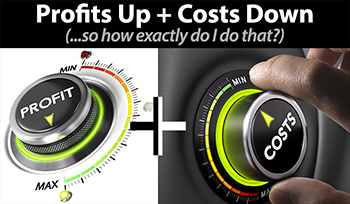Should a grout be installed on every polished concrete floor? The short answer is... no.…

1384 Bungalow Rd.
Morris, Illinois, U.S.A.
What should I charge for polished concrete?

Many people have asked me this question. So, I’ll answer this by showing myself as an example of how NOT to determine what you will charge for polished concrete, and how letting the market decide your price is absolutely the INCORRECT way to approach the pricing question.
When I was young in the contracting business, I thought only about price and not about profit. Profit in my mind was a foregone conclusion when I was bidding a contract that would easily be won for $250,000.
I calculated that the job would only take a few weeks to do. With a few people to pay to complete it and with our STI equipment never breaking down, I thought making money was going to be easy, right? Wrong!
In my experience, I have also seen many others fall into this trap by expecting a “fat check” after completion when actually they ultimately wasted company resources by not making all the money they needed to cover profit as well as business overhead.
Overhead is Absolutely Essential to Consider when Pricing
Overhead is the “fly-in-the-ointment,” the gremlin, the dirty word in business that is elusive to target, but definitely a business killer if left unchecked.
Overhead can be property costs (taxes/upkeep), utilities, vehicles, office staff, sales staff, service suppliers (think accountant, lawyer, etc.) – all the things that are essential to making it possible for a company to deliver its product but cannot be directly charged to any one project.
Today, my attitude for establishing a selling price has nothing to do with the market into which I intend to sell. I have learned that the selling price, instead, has everything to do with what your product costs plus the quality of the equipment it takes to produce it.
Consumables, labor, and equipment are all costs that are fixed and not able to be changed, so those have to factored in. But, now the question becomes “how do I not overprice myself?”
Cutting Corners Will Only Hurt Your Business

Well, you could negotiate a better rate for consumables, labor, and equipment, but it is very difficult in this world to get people and products reduced in cost without losing some level of quality.
The truth is if you want your abrasive tools to cost less by buying a lower quality diamond, over time those results will suffer. Maybe not to the initial, perceptible result, but sooner or later they will prove to be more expensive if the higher quality product was not used.
What if you decide to cut back on labor quantity or quality (skilled vs. unskilled workers) instead?
Will the project be finished as efficiently as possible, as well as on time?
And, what if the equipment you use is reduced in price & quality, but their constant breakdowns use up more labor to fix and the cost of parts?
How are you really saving money and time?
All of the above has to be considered as specified components of production needed to deliver a specified result when setting a price. Consumables, labor, and equipment are the most efficient, highest-value components that can be employed and any substitution will result in a greatly diminished result.
An Example of Miscalculated Profit
These unchangeable, tangible, fixed costs must be tallied before you can ever calculate profit.
Let’s say you decide that the means of producing your product costs $3.00/SF just to complete it. If you are getting the market rate of $3.50/SF, so can we conclude you are making $.50/SF profit? Not at all!
Sure, you may have $.50/SF left over, but what about overhead and business variables? What money will pay for that office phone line, your cell phone bill, or your ink cartridges? How will you pay for marketing programs, such as websites, advertising, & promotional programs?
Fifty cents more is just under a 15% margin – but if overhead is 10% (usually an acceptable amount), your profit is actually less than 5%. Five percent is nothing if that is supposed to finance your business variables as well as include an acceptable profit.
Consider the Market Price Last
While there are many factors to consider when calculating prices, any business owner must determine its cost to deliver its product first, then add overhead & business variables as well as appropriate profit margins. Only after that can he/she truly consider the market price.
If the business cannot make any money meeting that market price, then I highly recommend that you chase a much better market or change the quality of products you offer. The bottom line is an unprofitable company will never last, no matter how big its revenues.
© Substrate Technology, Inc.
For more information about job costing and advice about product and process costs, please do not hesitate to contact STI directly or an STI dealer for a customized project calculation sheet. We are all here to supply you solutions that save you time and make you money.
Related Posts
- Should a grout be installed on every polished concrete floor?
- I have scratches everywhere in my polished concrete! Why?
I have scratches everywhere in my polished concrete! Why? There are many possible reasons for…
- Should a grout be installed on every polished concrete floor?
Should a grout be installed on every polished concrete floor? The short answer is... no.…